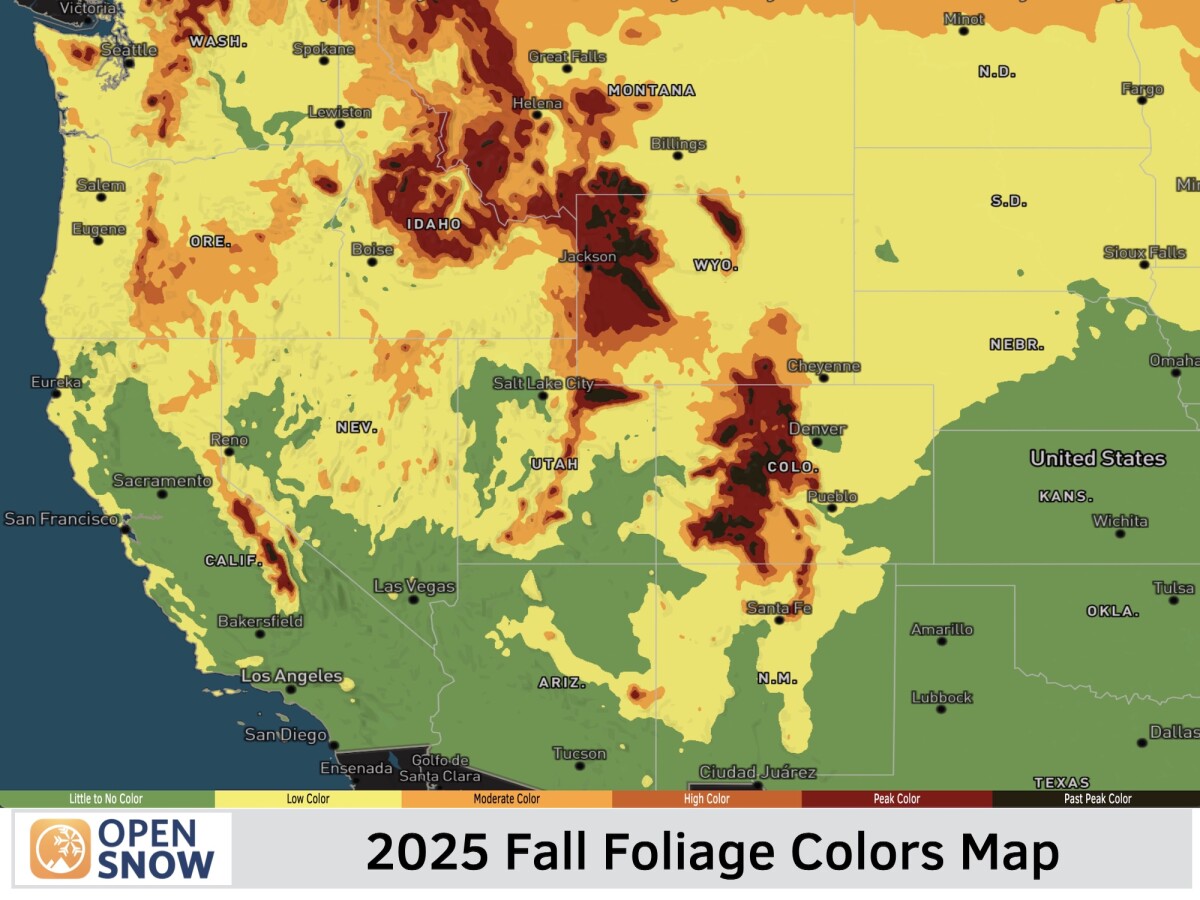News

By Luke Stone, Forecaster Posted 1 year ago June 7, 2024
Foehn Winds, Explained
Downslope winds, known in Europe as Foehn winds, significantly influence the region's weather, climate, and environment. The impacts of Foehn winds in Europe include rapid snowmelt and flooding, heightened avalanche risk, stress on crops and livestock, health issues, infrastructure damage, hazardous driving conditions, and an increased risk of wildfires. Foehn winds have been observed and documented for centuries, and remain an important research topic in the region. The various and diverse profound impacts of Foehn winds will be explored below.
Foehn winds in the Alps cause dramatic temperature increases, decreased humidity, and strong winds on the leeward side of the range. They occur when moist air is forced to ascend over a mountain range, causing it to cool and condense, resulting in precipitation on the windward side. The now dry air warms as it descends on the leeward side, resulting in a significant increase in temperature and a decrease in humidity. This process results in the characteristic warm, dry, and strong gusts associated with Foehn winds.
Flooding and Snowmelt
The warm temperatures resulting from Foehn winds cause rapid snowmelt in alpine regions, contributing to increased river flows and the potential for flooding in downstream areas. The sudden influx of meltwater can overwhelm river systems, particularly in late winter and spring when snowmelt is already a concern. This can lead to flash floods and river flooding, affecting downstream communities.
For example, in Austria, the Inn River basin is particularly susceptible to flooding following Foehn events. Rapid snowmelt and heavy precipitation can significantly increase river flow, causing floods that impact towns and villages along the river's course. The Tyrol region frequently experiences Foehn-induced flooding as well, particularly in spring. The combination of melting snow and additional rainfall can lead to severe flooding events, threatening both rural and urban areas.

Image: Satellite image of Foehn winds in the Austrian Alps, with a distinctive cloud-free zone immediately to the lee of the mountain chain and in the valleys. Courtesy of EUMeTrain.
The combination of heavy precipitation on the windward side and rapid snowmelt on the leeward side has contributed to flood events in Switzerland as well. Both the Rhine and Rhone rivers have historically experienced flooding events linked to Foehn winds.
Avalanche Risk
The rapid warming and drying effects associated with Foehn winds can decrease the stability of the snowpack and increase avalanche danger. When the surface layer rapidly warms, the temperature gradient between the surface and deeper down in the snowpack increases, and a weak layer can develop that is more prone to sliding. The melting snow produces meltwater that percolates down through the snowpack, acting as a lubricant between snow layers. This makes it easier for layers to slide as well. Strong Foehn winds redistribute the snow from windward to leeward slopes, resulting in wind loading and increased avalanche danger.

Image: Characteristic orographic clouds on the windward side of the Karawank Mountains in the Slovenian Alps disappear into a cloudless zone on the leeward side. Courtesy of Siemens.
During Winter storms, one side of the Alps often experiences heavy snow and cold temperatures, while the other side is warmer and mostly dry. Most often, during a Sudstau, moist air from the south is forced upward by the Alps and after crossing the Alpine crest, produces warm and dry conditions as well as strong winds on the northern side of the Alps. Similarly, during a Nordstau, the northern Alps will receive significant snowfall with warm and dry conditions on the southern side.


Image: Schematic representations of the typical characteristics of a southerly and northerly Foehn in the Alps. Courtesy of MeteoSwiss.
Agriculture and Livestock
Downslope winds significantly impact agriculture and livestock in a variety of ways. Rapid warming can cause heat stress in crops, slowing down growth, leading to wilting, and reducing overall crop yields. Rapid temperature changes lead to premature bud break on fruit trees in regions like the Swiss and Austrian Alps. This can make them vulnerable to subsequent frosts, damaging the buds and reducing yields.
Rapid warming in the Swiss Alps leads to reduced pasture quality as grasses dry out, impacting milk production and quality. In Tyrol, the impacts of Foehn winds on apple orchards and vineyards are significant.
The dry air associated with Foehn winds increases evapotranspiration rates, leading to significant moisture loss from both soil and plants. This can create drought-like conditions even in areas that typically have sufficient rainfall. Farmers often increase irrigation to compensate for the lost moisture.
Foehn winds have some positive impacts on agriculture in Europe also. The warmth brought by foehn winds can extend the growing season, allowing crops to mature more quickly, sometimes enabling an additional planting cycle. This can be particularly beneficial in cooler climates where growing seasons are typically short.
Strong downslope winds physically damage crops by breaking stems, dislodging fruits, and causing abrasion to leaves and stems from blowing dust and debris. These high winds also lead to soil erosion, particularly in dry conditions, removing the topsoil essential for nutrient availability and root stability, thereby reducing soil fertility and long-term agricultural productivity.

Image: Downed trees from Foehn winds on a slope in the Tatra Mountains of Poland. Courtesy of Adam Brzoza.
Health
The significant shifts in temperature and humidity caused by Foehn winds can trigger various health issues in the Alps and surrounding areas. Foehn sickness, also known as "Föhnkrankheit" in German-speaking regions, leads to headaches, fatigue, anxiety, difficulty concentrating, joint and muscle pain, and trouble sleeping. Residents of cities like Zurich (Switzerland) and Innsbruck (Austria) are known to experience Foehn sickness.
The dry and gusty conditions associated with Foehn winds can increase the concentration of dust, pollen, and other airborne particulates. This exacerbates respiratory conditions such as asthma, bronchitis, and other chronic respiratory diseases. Smoke from wildfires, which are often caused or intensified by downslope winds, can significantly degrade air quality and worsen respiratory conditions.
Foehn winds are a serious hazard to climbers in the mountains. The Eiger, a prominent peak in the Bernese Alps of Switzerland, is renowned for its challenging climbs, particularly the North Face.

Image: Eiger Mountain in the Bernese Alps of Switzerland. Courtesy of Jackson Droves.
The rapid temperature increases lead to sudden and significant changes in the climbing environment. This warming melts ice and snow, making routes more dangerous as they become unstable and prone to avalanches and rockfalls. The strong gusts associated with Foehn winds cause climbers to struggle to maintain their balance and secure their footing on exposed sections of the route. High winds can lift and carry small rocks, ice, and snow, which pose a direct danger to climbers.
Infrastructure
Foehn winds impact infrastructure in the European Alps and surrounding regions. These wind storms regularly cause damage to property and infrastructure. Wildfires caused or exacerbated by Foehn cause damage in the region as well. In cities like Zurich and Lucerne in Switzerland, Foehn winds lead to significant structural damage to buildings. The winds dislodge roof tiles, break windows, and cause other structural issues, especially in older buildings.
In the Tyrol region of Austria, Foehn winds frequently disrupt railway services. Fallen trees and debris blown onto tracks cause significant delays and accidents. The Austrian Federal Railways have had to develop extensive response strategies to mitigate these impacts, including deploying maintenance crews to clear tracks quickly during and after Foehn events.
In Bavaria, Germany, Foehn winds create hazardous driving conditions, particularly on the Autobahn and mountain roads. High winds can make it difficult for drivers, especially those operating high-profile vehicles like trucks and buses.
In Swiss alpine villages, Foehn winds cause power outages by knocking down power lines and damaging transformers.

Image: Typical valleys of Switzerland with southerly foehn (red) and northerly foehn (blue). Less common Foehn winds are indicated by dashed lines. Courtesy of MeteoSwiss.
The Swiss Federal Institute for Forest, Snow, and Landscape Research has documented multiple instances where strong winds have led to significant electrical infrastructure damage, necessitating emergency repairs and backup power solutions.
Wildfires
Foehn winds play an important role in wildfire activity in Europe, particularly in the Alpine regions. These winds dramatically change environmental conditions, making them more conducive to the ignition and rapid spread of wildfires.
Foehn winds drastically reduce humidity levels, leading to the rapid drying of vegetation. This desiccation process turns grasses, shrubs, and trees into highly flammable materials, significantly increasing the likelihood of wildfires. The strong gusts associated with Foehn winds can quickly spread flames across large areas, turning small fires into large wildfires. The winds carry embers and ignite new fires far from the original source. The combination of dry conditions, high temperatures, and strong winds can lead to more intense and fast-moving fires, which are much more difficult to control.
In the Valais region of Switzerland, Foehn winds have been linked to several significant wildfire events. The Carinthia region in Austria experienced Foehn winds that led to a series of wildfires in 2018 that caused widespread damage. In the South Tyrol region of Italy, Foehn winds contribute to wildfire activity. Firefighting teams in this region are on high alert during Foehn events, as the conditions can quickly turn favorable for large-scale fires. Foehn winds have created conditions that lead to large wildfires in Greece.

Image: Foehn winds created favorable conditions for this recent wildfire in Greece. Courtesy of Getty Images.
Summary
The rapid warming, reduced humidity, and strong winds associated with Foehn winds cause a variety of significant and far-reaching impacts across the Alps and nearby areas. These impacts include rapid snowmelt and flooding, increased avalanche risk, crop and livestock stress, health problems, infrastructure damage, hazardous driving conditions, and increased wildfire activity. Foehn winds are a powerful and multifaceted meteorological phenomenon with substantial disruptions that highlight the importance of understanding and preparing for these events. Advanced forecasting, public awareness, and adaptive strategies are essential for mitigating the challenges posed by Foehn winds, ensuring safety and resilience for the affected communities across Europe.
Luke Stone
Forecaster, OpenSnow
About The Author




